Home
> Scales
> Blues
Scales
All the scales featured on this page work over the standard 1 4 5 blues progressions, but I've made it clear when a scale can be used in a minor key, major key, or both.
You should use this lesson in conjunction with the lesson on soloing over blues, which goes into more detail on how to apply these scales melodically in your solos.
Make sure the root (1) of these scales is the same note as the 1 chord's root. For example, if the progression was E, A, B (1 4 5), E would be the root of our scale.
Start with the basic minor pentatonic scale...
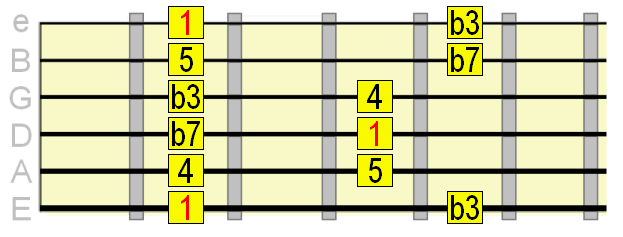
To blues it up, we can add in a flat 5th (b5) interval, commonly referred to as one of the "blue notes", along with the minor 3rd and minor 7th...
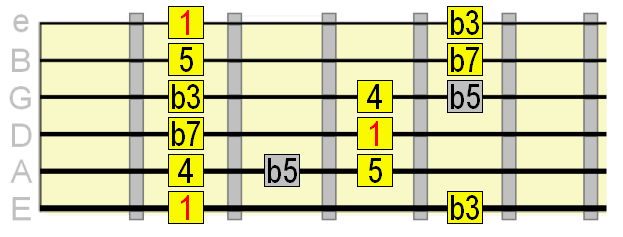
This is our elementary, six note blues scale. Using this scale alone will "do the job" as far as creating that bluesy sound when soloing.
But we can flesh the scale out even more by adding a passing major 7th interval as follows...
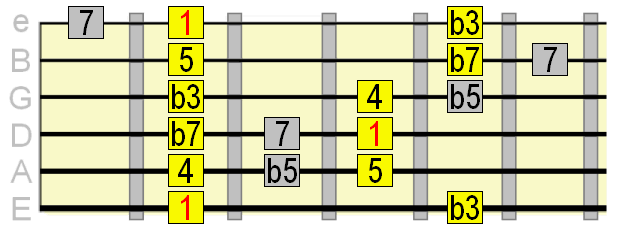
Musicians often refer to this major 7th blues scale as the "bebop blues scale" because of its common use in bebop jazz. It's typically used as a passing "bridge" between the b7 and root.
So, two embellishments to play around with - the flat 5th and the major 7th. Keep them under your fingers as we look at some minor and major key specific scales...
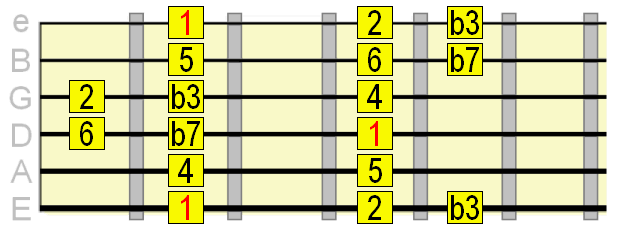
Natural minor (Dorian with a b6)...
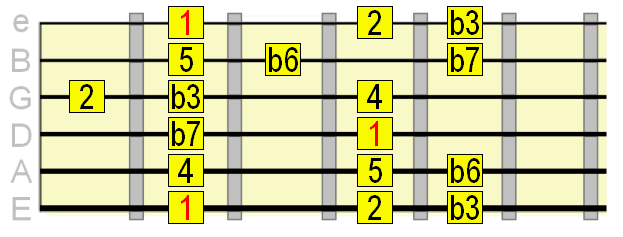
Or for something a little more tense, try melodic minor. It's the major 7th over the minor chord that gives it that dark quality...
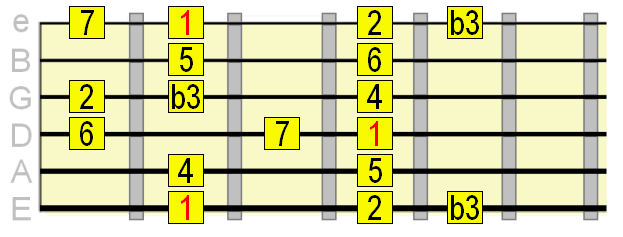
Or harmonic minor, which is basically melodic minor with a minor 6th (b6)...
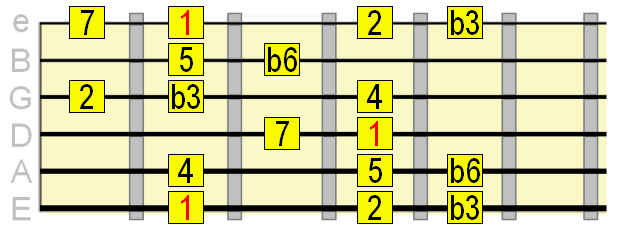
Specifically over the 5 chord...
If the 5 chord is minor - natural minor.
If the 5 chord is major - melodic/harmonic minor.
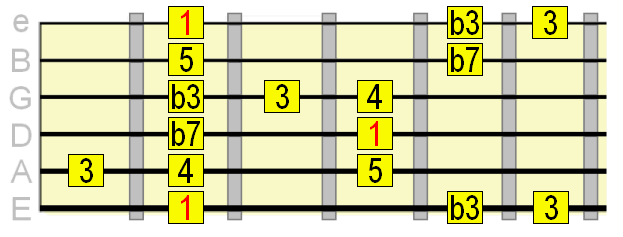
So if we were playing in the key of A major (A7, D7, E7), A7 would be our 1 chord, and typically we would resolve the minor 3rd of A minor pentatonic to the major 3rd in a phrase over that tonic chord.
The trick is to incorporate the major 3rd in to all the scale variations from earlier, with the b5, 7 and Dorian colour tones.
The major 3rd is the main "resolving tone" over that tonic (1) major chord in blues, along with the root, minor 7th and, to a lesser extent, the 5th.
You can also phrase using major pentatonic over that 1 chord (although you'll want to switch to the minor pentatonic variations from earlier over the 4 and 5 chords)...
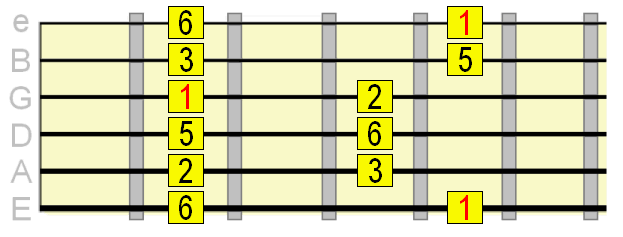
We can add in two chromatic, passing tones in the form of a minor 3rd (b3) and a minor 6th (b6)...
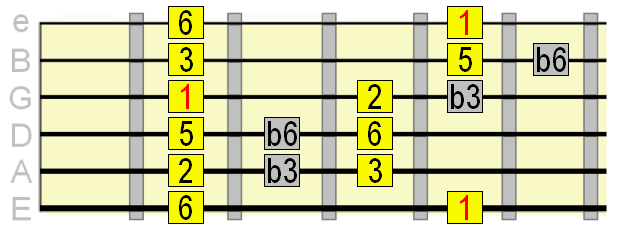
Or, to fill out your phrasing a bit more, try Mixolydian...
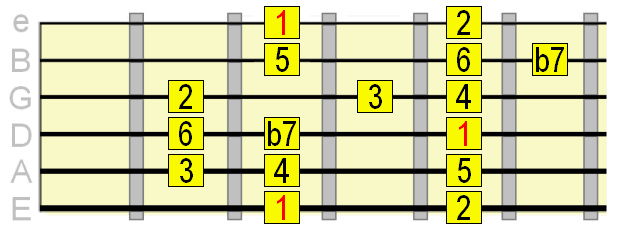
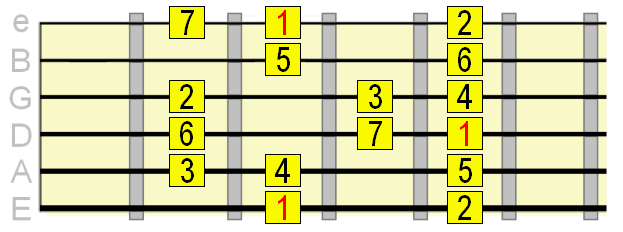
See this lesson on major blues scales to learn more about your options, including how to change scales through a chord progression.
Remember, these scale options are all in addition to the basic minor pentatonic and b5 variations from earlier that work over all chords in major and minor key blues!
I hope this lesson has given you some fresh scale ideas for your blues solos. Now go and experiment with them!
Share your thoughts...
Have any questions, thoughts or ideas about this lesson? Let us know using the comments form below.
12 Blues Guitar Scales - Beyond Pentatonics
This lesson will explore the many different blues guitar scales used in all the blues sub-genres.All the scales featured on this page work over the standard 1 4 5 blues progressions, but I've made it clear when a scale can be used in a minor key, major key, or both.
You should use this lesson in conjunction with the lesson on soloing over blues, which goes into more detail on how to apply these scales melodically in your solos.
Basic blues guitar scales - embellishing minor pentatonic
These scales work well over both major and minor key blues progressions.Make sure the root (1) of these scales is the same note as the 1 chord's root. For example, if the progression was E, A, B (1 4 5), E would be the root of our scale.
Start with the basic minor pentatonic scale...

To blues it up, we can add in a flat 5th (b5) interval, commonly referred to as one of the "blue notes", along with the minor 3rd and minor 7th...

This is our elementary, six note blues scale. Using this scale alone will "do the job" as far as creating that bluesy sound when soloing.
But we can flesh the scale out even more by adding a passing major 7th interval as follows...

Musicians often refer to this major 7th blues scale as the "bebop blues scale" because of its common use in bebop jazz. It's typically used as a passing "bridge" between the b7 and root.
So, two embellishments to play around with - the flat 5th and the major 7th. Keep them under your fingers as we look at some minor and major key specific scales...
Minor key blues scales
Try mixing phrases using the above minor pentatonic variations with the following...Over the 1 chord
Dorian, which adds a major 2nd and 6th to minor pentatonic...
Natural minor (Dorian with a b6)...

Or for something a little more tense, try melodic minor. It's the major 7th over the minor chord that gives it that dark quality...

Or harmonic minor, which is basically melodic minor with a minor 6th (b6)...

Over the 4 and 5 chords
Again, either natural minor, melodic or harmonic minor as above. But avoid Dorian over the 4 and 5 chords as some of its notes will clash with the chord tones being played.Specifically over the 5 chord...
If the 5 chord is minor - natural minor.
If the 5 chord is major - melodic/harmonic minor.
Major key blues scales
Many blues solos move seamlessly between major and minor tonality.Over the 1 chord
Minor pentatonic has an inherently minor flavour (because of the minor 3rd interval), yet it still works well in major key blues and is partly responsible for the blues sound. However when playing in a major key, we should add in the major 3rd over that 1 chord to support its major tonality...
So if we were playing in the key of A major (A7, D7, E7), A7 would be our 1 chord, and typically we would resolve the minor 3rd of A minor pentatonic to the major 3rd in a phrase over that tonic chord.
The trick is to incorporate the major 3rd in to all the scale variations from earlier, with the b5, 7 and Dorian colour tones.
The major 3rd is the main "resolving tone" over that tonic (1) major chord in blues, along with the root, minor 7th and, to a lesser extent, the 5th.
You can also phrase using major pentatonic over that 1 chord (although you'll want to switch to the minor pentatonic variations from earlier over the 4 and 5 chords)...

We can add in two chromatic, passing tones in the form of a minor 3rd (b3) and a minor 6th (b6)...

Or, to fill out your phrasing a bit more, try Mixolydian...

Over the 4 chord
In addition to the minor pentatonic and b5 variations from earlier, try phrasing around a Dorian pattern (see earlier) built on the 1 chord root (it works because Dorian in the 1 chord position translates to Mixolydian over the 4 chord. For example, in the key of A major, playing A Dorian over the D7 chord is the same as playing D Mixolydian)...Over the 5 chord
Play the Ionian/major scale in the 1 chord root position. This, again, translates to Mixolydian over the 5 chord...
See this lesson on major blues scales to learn more about your options, including how to change scales through a chord progression.
Remember, these scale options are all in addition to the basic minor pentatonic and b5 variations from earlier that work over all chords in major and minor key blues!
I hope this lesson has given you some fresh scale ideas for your blues solos. Now go and experiment with them!
| Was this
helpful? Please support this site. I really appreciate it! |
Stay updated
and learn more Sign up to the newsletter for updates and grab your free Uncommon Chords book |
Share your thoughts...
Have any questions, thoughts or ideas about this lesson? Let us know using the comments form below.








